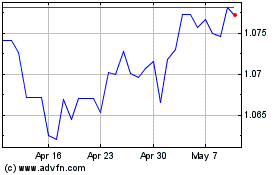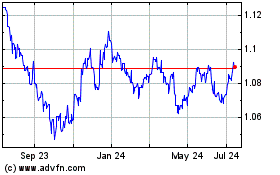Euro Mixed After Eurozone GDP Data
February 14 2020 - 1:39AM
RTTF2
The euro was trading mixed against its major counterparts in the
European session on Friday, after a data showed that the euro area
economy grew as initially estimated in the fourth quarter.
Flash estimates from Eurostat showed that gross domestic product
grew only 0.1 percent sequentially, following third quarter's 0.3
percent expansion. The rate came in line with the flash
estimate.
The 0.1 percent expansion was the slowest growth since early
2013.
On a yearly basis, economic growth eased to 0.9 percent from 1.2
percent in the third quarter. The fourth quarter growth was revised
down from 1 percent.
In the fourth quarter, the number of people in work increased at
a faster pace of 0.3 percent sequentially, faster than the 0.1
percent rise in the third quarter. On a yearly basis, employment
growth held steady at 1 percent.
Another report from Eurostat showed that the trade surplus
increased in December as exports increased from November, amid a
fall in imports.
The trade surplus rose to EUR 22.2 billion in December from EUR
19.1 billion in November. Exports grew 0.9 percent, while imports
fell 0.7 percent.
On an unadjusted basis, the trade surplus totaled EUR 23.1
billion versus EUR 16.3 billion a year ago. Exports advanced 4.8
percent and imports gained 1.1 percent annually.
Preliminary figures from Destatis showed that German economy
stagnated in the fourth quarter of 2019 amid slower consumption and
weaker exports.
Gross domestic product was unchanged from the previous quarter
on a seasonally and calendar-adjusted basis. Economists had
forecast 0.1 percent growth.
The currency showed mixed trading in the Asian session. While it
dropped against the greenback and the yen, it held steady against
the pound. Versus the franc, it rose.
The euro rose to a 2-day high of 1.0642 against the franc, after
falling to 1.0609, which was its lowest level since August 2015.
The next possible resistance for the euro is seen around the 1.08
area.
The euro bounced off to 1.0850 against the greenback, from near
a 3-year low of 1.0827 set at 7:00 pm ET. The euro may challenge
resistance around the 1.10 mark.
After dropping to a 4-month low of 118.87 in the Asian session,
the euro recovered to 119.14 against the yen. On the upside, 121.00
is likely seen as the next resistance for the euro.
Data from the Ministry of Economy, Trade and Industry showed
that Japan's tertiary industry activity declined unexpectedly in
December.
The tertiary industry activity index fell 0.2 percent
month-on-month in December. Economists had forecast a 0.1 percent
rise.
The euro held steady against the pound, after reaching as high
as 0.8331 at 4:15 am ET. At yesterday's trading close, the pair was
valued at 0.8307.
Looking ahead, U.S. business inventories for December,
University of Michigan's preliminary consumer sentiment index for
February, retail sales, import and export prices and industrial
production, all for January, will be featured in the New York
session.
Euro vs US Dollar (FX:EURUSD)
Forex Chart
From Mar 2024 to Apr 2024

Euro vs US Dollar (FX:EURUSD)
Forex Chart
From Apr 2023 to Apr 2024
